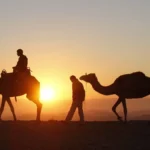Discover Who are the Berbers, their Culture, Origin, Lifestyle, Art, Music, and much more! Travel guide to know the Berbers of Morocco.
The Berbers: are native to North Africa and there are an estimated 30 to 40 million Berber-speaking people in Africa. Most live in Morocco and Algeria, with pockets of Berbers residing in Tunisia, Libya, Mauritania, Mali, and Niger. Other nations with smaller populations include Egypt and Burkina Faso.
Origin and lifestyle of the Berbers of Morocco
Before the invasion of the Arabs in the 7th century, the Berbers were Christians, Jews, or animists. An animist believes that not only humans have souls and spirits, but that all plants, animals, and even the earth are spiritual, and connect us to each other. The Arab nation forced the Berbers to become Muslims when they were subjugated.
The Berbers have a long and ancient history, much of which has been overlooked because the ancient peoples had no written language. The discovery of cave drawings provided the first indication of their past. North African cave paintings up to 12,000 years old have been found at Tadrart Acacus, Libya. Many of the paintings depict agricultural activities and domestic animals. Paintings have also been found at Tassili n’Ajjer in southeastern Algeria.

The religion of the Berbers
The vast majority of the Berber community is Islamic (Sunni Muslims). A large Berber Jewish population could be found in Morocco until the 1960s, now much smaller after their numbers decreased dramatically as a result of emigration. Many Christian Berbers have also emigrated, mainly to France, and only a few remain in Morocco.
Berber social structure
Each tribe has a fairly distinct hierarchy, yet the structure of the chain of command varies depending on the locale. There will be a leader for each tribe, and in the Middle Ages, some of these leaders were female. The most well-known is perhaps Kabylia, who defended her people against the French.
Usually, it is the men who choose a wife for themselves within their tribe, but in some tribes, the decision is taken from him and made by the families. Nevertheless, in the Tuareg tribe, the woman gets to pick the man she wants to wed. Whether a tribe has a patriarchal or matriarchal family structure will depend on the tribe. Strict adherence to custom has given the Berber people a strong sense of unity and protected their culture.
Berber art and culture
The culture and traditions within each Berber community are very tribal and will differ from region to region. Daily life is nomadic, with men tending the livestock and women tending the family and crafts. The community will move to ensure that the livestock has sufficient grazing, water, and shelter. This allows the women to continuously collect different plants that they will use to dye wool and cotton. Their livestock provides them with wool that they use to weave kilims, a tapestry-like woven carpet. Sometimes they are made for personal use, but often they are also sold in local souks (markets). The patterns woven into kilims are distinctive and characteristic of the tribe and region. Moroccan Berber women like to embellish their kilims with fringe and sequins, while other Berber weavers from different regions will simply use geometric designs such as diamonds and triangles.
Berber art is primarily crafted and expressed as portable or wearable pieces, such as pottery, furniture, fabrics, jewelry, or rugs. Artistic design is also represented in their architecture.
Moroccan Berber Music
Moroccans adore music, and every celebration includes it as a key component.
The music of the people is performed with flutes and drums; The rhythmic beat is usually accompanied by groups of dancers. Both men and women participate, although in some regions only men are allowed to dance. This music is rarely heard in the cities.
At rituals, including weddings, music is played. It is also played to ward off evil spirits.
Berber Cuisine
As with all Berbers, the style of cooking and variety of food differ from tribe to tribe. Inevitably, the various cultural invasions over the generations have influenced and developed Berber cuisine. However, some of the basic ingredients such as couscous still remain.







